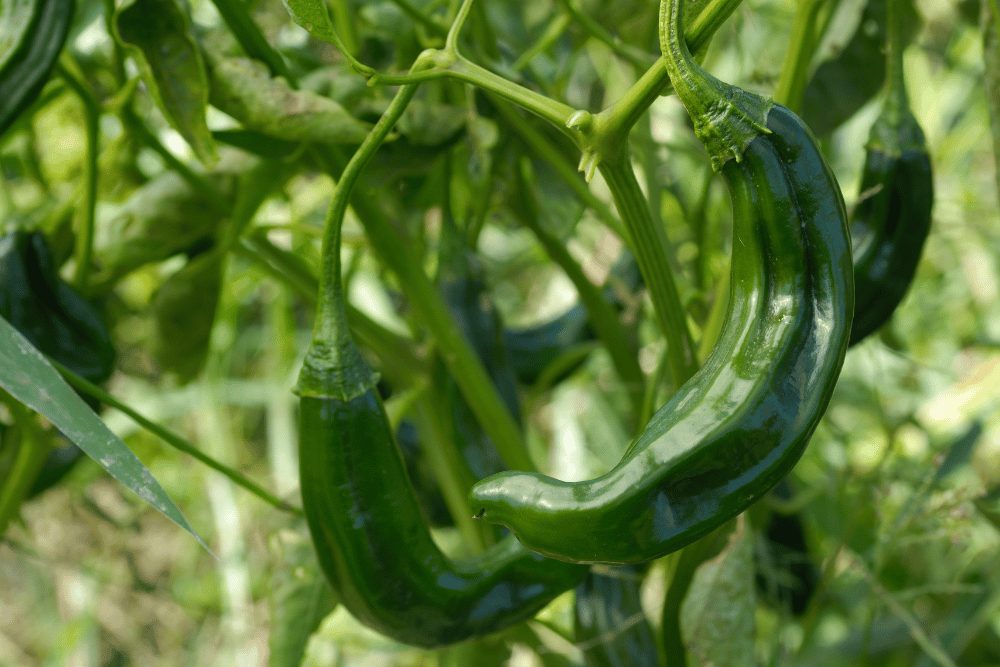Dried chilaca peppers form part of the "holy trinity" of peppers used to make mole sauce and are one of the many Mexican peppers whose fresh and dried forms go by different names. Their mild heat and versatility in the kitchen make chilaca peppers a popular, family-friendly chile.
What Are Chilaca Peppers?
Chilaca peppers are elongated, narrow chile peppers grown for their family-friendly heat and slightly sweet flavor.
Origin
Chilaca peppers originate from Mexico in the state of Puebla, where they have been cultivated since ancient times. The state is also home to poblano peppers, which are often confused with chilacas.
Names
The fresh form is called the chilaca pepper or chilaca chile. When they are dried, chilacas go by the name chile negro, chile pasilla, pasilla bajio, or pasilla pepper. ‘Pasilla’ means ‘little raisin’ in Spanish, referring to the raisin-like undertones and wrinkly texture of dried chilaca peppers.
Chilaca peppers also have other names like Mexican negro, cuernillo, and prieto.
Color
Unlike most peppers, chilaca peppers turn red first. As they are left to ripen on the plant, they turn a dark green to dark brown after about 85 days.

Size And Shape
Chilaca peppers are long chiles that reach 6-9 inches long and 1 inch wide at full maturity. The long, narrow pods have a flattened to curved conical shape.
Texture
When mature, fresh chilaca peppers are waxy and have wrinkled skin with vertical ridges. The flesh beneath the skin is crisp and thin, housing a narrow cavity with cream-colored seeds.
The name of the pepper draws from the wrinkly nature of its skin. ‘Chilaca’ means ‘gray hair’ or ‘old’ in the Aztec language.
Flavor
If you prefer peppers with a floral, mildly tangy flavor and a heat level similar to that of poblano peppers, you should enjoy chilaca peppers.
Mature chilaca chile peppers have an earthy, slightly sweet taste with hints of raisin.
Is A Chilaca Pepper The Same As A Poblano?
People often confuse poblano peppers and chilaca chiles. While they are both members of the Capsicum annuum species, they are different peppers.
The shape of a poblano chile resembles that of a flattened bell pepper—it’s shorter and wider than a chilaca pepper, which is long and slender.
Both chilaca and poblano peppers ripen to dark green and eventually to brown when they are harvested and dried. Once dry, both chiles are very dark—almost black—with a wrinkly texture.
Poblano peppers are available in two dried types—ancho peppers (1,000-1,500 SHUs) and mulato peppers (2,500-3,000 SHUs).
Chilca peppers are dried and become chile pasilla (250-2,500 SHUs).
Both dried chiles have similar flavors and heat levels, and they’re often used together as part of the ‘holy trinity’ of Mexican chiles.

How Hot Is A Chilaca Pepper?
The heat level of chilaca peppers is only 1,000-2,500 SHUs on the Scoville Scale. They are mildly hot peppers, a quality that endears them to chefs and home cooks as a family-friendly pepper.
Depending on where you grow them and the growth conditions, some chilaca can have as little as 250 Scoville Heat Units, especially when harvested unripe.
For reference, the hottest chilaca pepper is as spicy as the mildest red jalapeno pepper and as hot as the hottest cascabel chile (1,500-2,500 SHUs) or the spiciest Anaheim pepper (500-2,500 SHUs).
At (2,500-5,000 SHUs) guajillo peppers (dried mirasol peppers) have the same heat level on the lower end as the spiciest chilaca pepper and are five times hotter than the mildest chilaca.
What Are Chilaca Peppers Used For?
Chilaca peppers may not be as versatile and famous as jalapeno peppers, but they are gaining ground with more chefs and home cooks preferring them for family-friendly spice levels.
You can use fresh chilaca peppers for applications such as:
- Making enchilada sauce.
- Grilling and slicing the peppers into strips for rice, casseroles, stews, soups, and vegetable dishes.
- Roasting them for tacos, tamales, chile rellenos, and tostadas.
- Pickling the peppers in vinegar, spices, and salt to eat as a snack.
- Dicing into salads and salsa, such as salsa de chile chilaca.
- Blending into hot sauces and cream-based sauces.
If you prefer pasilla chiles, here’s what you can do with them:
- Crush the whole dried peppers and sprinkle the flakes over tortilla soup.
- Grind the dried peppers into a chili pepper powder. The powder can make sauces and marinades for meat.
- Use pasilla chili powder as a dry spice rub for meats like pork chops and chicken.
- Use pasilla salsa or sauce as a dip for snacks like tortilla chips.

Besides the above applications, you can use chilaca or pasilla peppers to make popular dishes such as:
- Mole sauce, which is made with the Mexican cuisine ‘holy trinity’ of mulato, ancho, and pasilla peppers with tomatoes, nuts, chocolate, and even raisins. You can also add guajillo peppers into the mix.
- Rajas de Chilaca con Crema, which is made with roasted chilaca pepper strips, onions, and corn in cream sauce.
- Mexican tortilla soup.
The thing to remember when using chilaca peppers is that a recipe calling for chilacas requires the fresh version, while one calling for pasillas requires dried chilaca chiles.
Where To Buy Chilaca Peppers?
Fresh chilaca peppers are very rare, even in local Mexican markets. Pasillas are more common and can be sold when dried whole or ground into a fine powder.
You can try your luck in the US at specialty stores, Mexican grocers, high-end supermarkets, farmers’ markets, and online vendors like Amazon.
Can You Grow Chilaca Peppers?
Rather than go through the trouble of sourcing fresh chilaca peppers, you can grow your own in the garden or in outdoor containers!
Buy chilaca pepper seeds online from Amazon and other outlets and start them indoors about 8-10 weeks before the last frost. The seeds will take about three weeks to sprout.
Once they grow into strong young pepper plants, transfer them outdoors in fertile soil in the garden or sizable growing containers. Plant the seedlings 18-36 inches apart, where they can have 6-8 hours of sun daily.
Chilaca pepper plants do well as perennials in warm tropical climates or as annuals in colder climates with summer growing seasons. They mature about 85 days from planting.
Substitutes For Chilaca Peppers
Mild Mexican peppers like poblanos and anchos are perfect substitutes for chilacas and pasilla peppers.
If you want the same heat level or a spicier kick, replace dried chilaca peppers with mulato peppers, guajillos, chipotle (smoked, dried jalapenos), and cascabels. For a spicier fresh pepper, try jalapenos or Fresno peppers.

